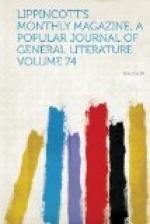[Illustration: The quinta de la Miseria.]
The train on its way to Paraguari passes Trinidad and many other stations. The station-houses are all small structures covered with tile roofs. At Luque, a village where the passengers stop for refreshments, the women of the place flock at the windows and offer for sale embroideries of their own invention worked on tulle or on a special kind of netting, while the venders of lunches appear, not with the traditional fried oysters, fried chickens or sandwiches of our own favored land, but with bottles of fresh milk and chiapa, a kind of bread made from manioc, among the ingredients of which are starch and eggs, and for which Luque is famous. The engineer of the train, an Englishman, is a person who is as important in his way as is the Brazilian minister in his. At Luque he descends from his locomotive to chat with a friend on the platform. Time—or what would be “time” elsewhere—is up, but our Englishman continues to talk, notwithstanding that after the utterance of impatient cries the passengers leave the cars in wrath to crowd around him and overwhelm him with abusive words. An admirable representative of English phlegm, he finishes his conversation at his ease, looks at his watch, climbs in a leisurely way to his position on the engine and puts the train in motion. There is no danger of collision with any other train, however, for this train is the only one on the line. It leaves Asuncion every morning, moving at an average rate of fifteen miles an hour, and arrives at Paraguari some time during the day, at the will of the engineer. Returning from Paraguari the same day, it reaches Asuncion, remarks M. Forgues, when it pleases Heaven that it shall do so.
[Illustration: How the poor travel in Paraguay.]
The scenery along the road is beautiful, but the country is almost a desert. Around the stations are groups of dwellings of varied appearance, the most solidly built of which are connected with farms that belonged to the late President Lopez. At times appear palm trees, the feathery leaves of which mingle with beautiful effect with the pale or dark foliage of an exuberant vegetation. Lopez had established telegraphic communication between the mouth of the Paraguay and Paraguari, but the line having been broken between the latter terminus and a place called Cerro Leon, and nobody having been sufficiently interested in it to have it repaired, it now stops at Cerro Leon, the only telegraphic wire in the country, as the Asuncion and Paraguari Railroad is the only railroad.




